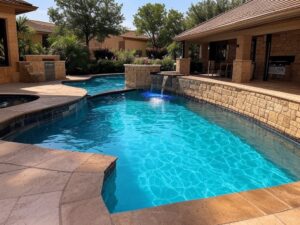Prime a pool pump is essential for maintaining proper water circulation and keeping your pool clean. When your pump loses its prime, it can’t effectively move water through the system. This guide will walk you through the complete process of priming your pool pump, common issues you might face, and helpful maintenance tips to prevent future problems.
Understanding Pool Pump Priming Basics
Your pool pump serves as the heart of your swimming pool’s circulation system. When we talk about priming a pool pump, we’re referring to the process of removing air from the pump and suction lines, allowing water to flow freely through the system.
The presence of air in your pump can cause significant problems, from reduced efficiency to potential damage to your equipment. That’s why knowing how to properly prime your pump is crucial for every pool owner.
Signs Your Pool Pump Needs Priming
A pool pump won’t prime properly when certain issues arise. Understanding these warning signs helps you address problems before they become severe.
Watch for these indicators: loud gurgling sounds from the pump, visible air bubbles in the pump basket, weak water flow from return jets, and the pump running but not moving water. These symptoms often signal that your pump needs immediate attention.
Essential Tools for Pool Pump Priming
Before starting the prime pool pump process, gather these necessary tools:
A garden hose, pump lid removal tool, bucket of water, and safety equipment like gloves. Having everything ready beforehand makes the process smoother and more efficient.
How to Prime Pool Pump
1. Initial Preparation Steps
Turn off the pump at the circuit breaker for safety. Remove the pump lid carefully, checking for any damage to the O-ring. Clean the basket of any debris that might interfere with water flow.
This preparation ensures a clean starting point and helps prevent complications during the priming process.
2. Starting the Priming Process
When prime a pool pump, begin by filling the pump basket with water from your garden hose. Make sure the lid is properly sealed to prevent air from entering the system.
Pay special attention to the O-ring placement, as improper seating can cause air leaks and prevent successful priming.
3. Advanced Priming Techniques
For stubborn cases where the pool pump won’t prime, try this advanced method: close all valves except one suction line, then gradually open them one at a time while the pump runs.
This technique helps concentrate the suction power and often resolves difficult priming situations more effectively.
Troubleshooting Common Priming Issues
Air Leaks and Solutions
Air leaks are the most common reason why a pool pump won’t prime. Check all connections, including unions, valve stems, and the pump lid, for potential air entry points.
Apply thread tape to threaded connections and replace any damaged O-rings or gaskets that might be allowing air into the system.
Water Level Problems
Low water levels in your pool can prevent proper priming pool pump operation. Ensure your pool water level reaches at least halfway up the skimmer opening.
Maintaining proper water levels not only helps with priming but also protects your pump from running dry and getting damaged.
Maintaining Prime in Your Pool Pump
Regular Maintenance Schedule
Establish a routine maintenance schedule for your pump. Regular checks help prevent priming issues and extend the life of your equipment.
Check the pump basket weekly for debris, inspect O-rings monthly, and test for air leaks at least once per season.
Prevention Tips
To avoid frequent pool pump priming problems, implement these preventive measures: keep the water level consistent, clean the pump basket regularly, and check for air leaks periodically.
Small maintenance tasks can prevent larger issues and reduce the need for frequent priming.
Advanced Pool Pump Priming Techniques
Dealing with Stubborn Air Locks
Sometimes, traditional methods aren’t enough when prime a pool pump. For persistent air locks, try bleeding air from the filter’s air relief valve while the pump runs.
This technique often helps remove trapped air pockets that prevent proper priming.
Professional Tips and Tricks
Professional pool technicians often use specific techniques when priming pool pump systems. One effective method involves using a shop vacuum to create additional suction.
These advanced techniques can be particularly useful for dealing with complex priming situations.
Safety Considerations During Priming
Electrical Safety
Always prioritize safety when working with pool equipment. Ensure your hands are dry when handling electrical components, and never adjust the pump while it’s running.
Following proper safety protocols protects both you and your equipment during maintenance.
Pressure Management
Monitor pressure gauges during the priming pool pump process. Excessive pressure can damage equipment and create safety hazards.
Understanding normal pressure ranges helps you identify potential problems before they become dangerous.
Long-term Pool Pump Care
Seasonal Maintenance Tips
Different seasons require different approaches to pool pump priming and maintenance. Prepare for winter by properly draining and storing pump components.
Spring startup requires careful attention to priming procedures to ensure smooth operation throughout the swimming season.
Equipment Upgrades and Modifications
Consider upgrading older pump components to improve priming efficiency. Modern pumps often include features that make prime a pool pump easier and more reliable.
Investments in quality equipment can reduce maintenance needs and improve overall pool operation.
Frequently Asked Questions about Prime a Pool Pump
What does it mean to prime a pool pump?
- Priming removes air from the pump and fills it with water to ensure proper functioning.
Why is priming a pool pump necessary?
- It helps the pump create suction to circulate water effectively.
How often should I prime my pool pump?
- Only when air enters the system, such as after maintenance or a dry spell.
What tools do I need to prime a pool pump?
- A garden hose, water source, and access to the pump lid.
How long does it take to prime a pool pump?
- Typically, it takes 2–5 minutes to prime the pump fully.
Conclusion
Understanding how to prime a pool pump properly is crucial for maintaining your pool’s health and functionality. By following this comprehensive guide, you’ll be better equipped to handle priming issues and maintain your pool pump effectively.
Remember that regular maintenance and prompt attention to problems can prevent most priming issues. When in doubt, don’t hesitate to consult a professional pool service provider for assistance.
Learn how to prime a pool pump effectively with our detailed guide. From troubleshooting to maintenance tips, master the essential steps for optimal pool pump performance. These advanced techniques can be particularly useful for dealing with complex priming situations.




